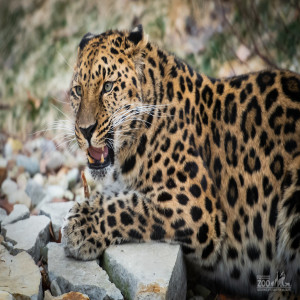 Amur leopards are relatively small in size. Males range from 42-54 inches, with a tail length of 32-35 inches. They weigh between 70-125 pounds. This cat’s coat ranges in color from various shades of yellow to gold and is covered in dark spots and rosettes. The Amur Leopard’s rosettes are widely spaced and are larger than those seen on other leopards. For camouflage in the snow, their coat is paler than other leopard species. The Amur Leopard is adapted to the cool climate by having thick fur which grows up to 3 inches longer in the winter. Their longer legs enhance their ability to walk in deep snow as well as jump up to 10ft. Their tongue has tiny rasp or hooks, called denticles, which are used to scrape the meat off the bones of their prey. The Amur Leopar is considered to be one of the most critically endangered big cats in the world, with less than 100 remaining in the wild.
Amur leopards are relatively small in size. Males range from 42-54 inches, with a tail length of 32-35 inches. They weigh between 70-125 pounds. This cat’s coat ranges in color from various shades of yellow to gold and is covered in dark spots and rosettes. The Amur Leopard’s rosettes are widely spaced and are larger than those seen on other leopards. For camouflage in the snow, their coat is paler than other leopard species. The Amur Leopard is adapted to the cool climate by having thick fur which grows up to 3 inches longer in the winter. Their longer legs enhance their ability to walk in deep snow as well as jump up to 10ft. Their tongue has tiny rasp or hooks, called denticles, which are used to scrape the meat off the bones of their prey. The Amur Leopar is considered to be one of the most critically endangered big cats in the world, with less than 100 remaining in the wild.
Location: Asian Highlands
Share:
Range
The Amur Leopard range previously encompassed the Amur River Basin and the mountains of northeastern China and the Korean Peninsula. Today, wild Amur Leopards are confined to a fragmentary range in the Primorye region of the Russian Far East just north of Korea, and there may be a few individuals in the adjacent Jilin Province of China.
Habitat
The Amur Leopards maintain individual territories approximately 20-120 miles in size. Their habitat occurs in any area that provides reasonable cover in temperate forests. They live in river basins in mountainous areas, and favor southern facing slopes during the winter.
Conservation Status
Endangered
Primary Threats
Human Wildlife Coexistence, Hunting Illegal Trade
Gestation
Females first breed at an age of 3-4 years. Their gestation period is around 12 weeks.
Litter
Litters may be 1 to 4 cubs, with the average litter size of just over 2.
Behavior
The leopard is a solitary hunter that ventures out under cover of darkness. Prey is carried off and cached to keep it safe from competitors. The cold adapted leopard lives for 10-15 years in the wild and remains fertile to the end of its life. In captivity, they can live to 20 years. Leopards give a distinctive rasping call, rather than a growl, as their main vocalization.
Reproduction
Males and females apparently pair up and cooperate during breeding season, possibly raising their cubs together before taking their separate ways again.
Wild Diet
Prey consists of musk deer, roe deer, moose, wild pig, Manchurian Wapiti (elk), hare badger, fowl, mice, and at times young black bears.
Zoo Diet

